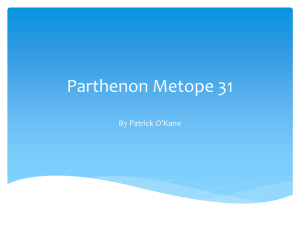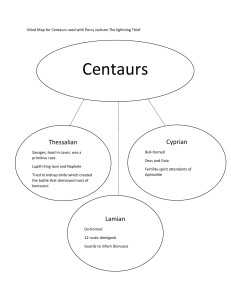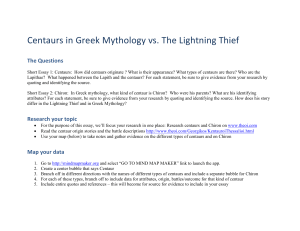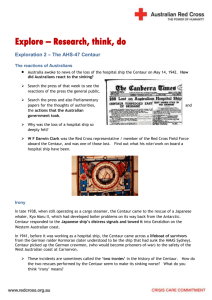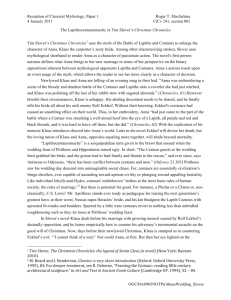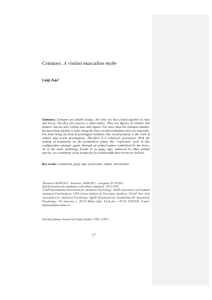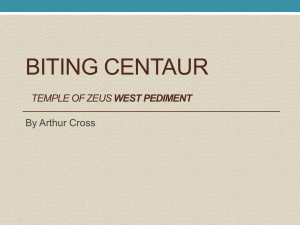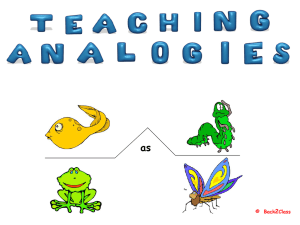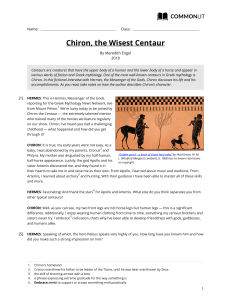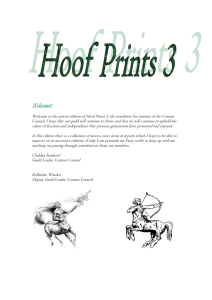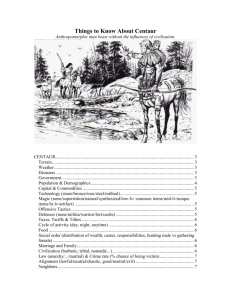Et in Arcadia CGI: Centaurs in Contemporary Cinema From the
advertisement
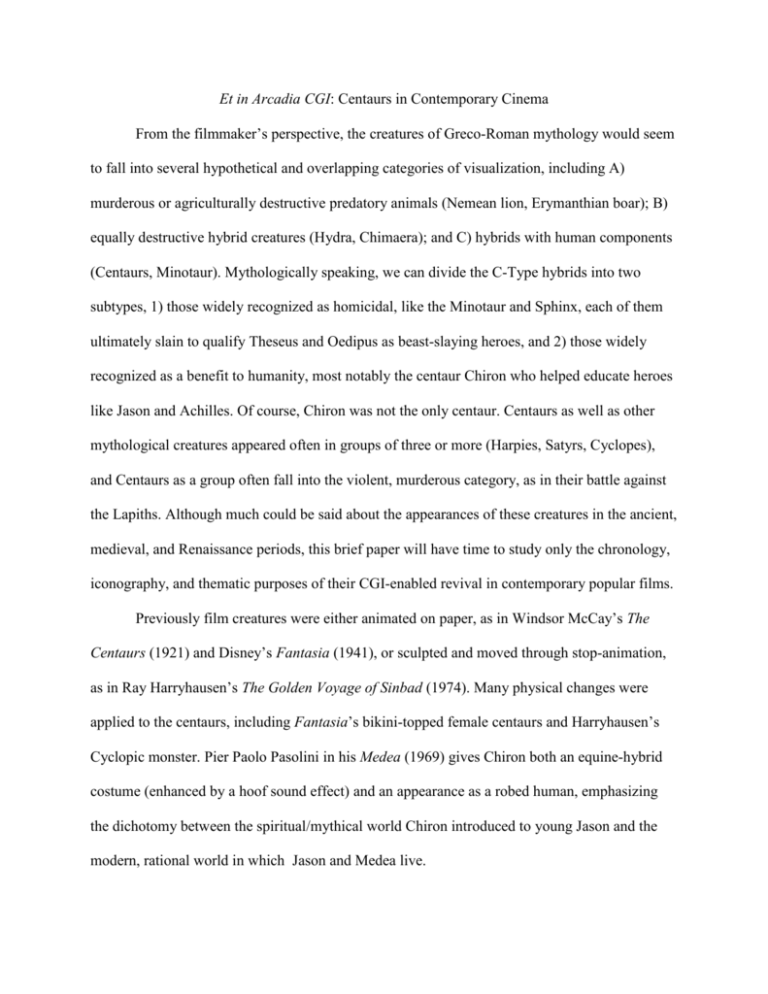
Et in Arcadia CGI: Centaurs in Contemporary Cinema From the filmmaker’s perspective, the creatures of Greco-Roman mythology would seem to fall into several hypothetical and overlapping categories of visualization, including A) murderous or agriculturally destructive predatory animals (Nemean lion, Erymanthian boar); B) equally destructive hybrid creatures (Hydra, Chimaera); and C) hybrids with human components (Centaurs, Minotaur). Mythologically speaking, we can divide the C-Type hybrids into two subtypes, 1) those widely recognized as homicidal, like the Minotaur and Sphinx, each of them ultimately slain to qualify Theseus and Oedipus as beast-slaying heroes, and 2) those widely recognized as a benefit to humanity, most notably the centaur Chiron who helped educate heroes like Jason and Achilles. Of course, Chiron was not the only centaur. Centaurs as well as other mythological creatures appeared often in groups of three or more (Harpies, Satyrs, Cyclopes), and Centaurs as a group often fall into the violent, murderous category, as in their battle against the Lapiths. Although much could be said about the appearances of these creatures in the ancient, medieval, and Renaissance periods, this brief paper will have time to study only the chronology, iconography, and thematic purposes of their CGI-enabled revival in contemporary popular films. Previously film creatures were either animated on paper, as in Windsor McCay’s The Centaurs (1921) and Disney’s Fantasia (1941), or sculpted and moved through stop-animation, as in Ray Harryhausen’s The Golden Voyage of Sinbad (1974). Many physical changes were applied to the centaurs, including Fantasia’s bikini-topped female centaurs and Harryhausen’s Cyclopic monster. Pier Paolo Pasolini in his Medea (1969) gives Chiron both an equine-hybrid costume (enhanced by a hoof sound effect) and an appearance as a robed human, emphasizing the dichotomy between the spiritual/mythical world Chiron introduced to young Jason and the modern, rational world in which Jason and Medea live. Newly developed computer animation software like Alias Research’s PowerAnimator in the early 1990s perfected the 3D modeling of robots and dinosaurs in such high-profile feature films as James Cameron’s Terminator 2: Judgment Day (1991) and Stephen Spielberg’s Jurassic Park (1993). In 1994 Sam Raimi and Robert Tapert then produced the popular syndicated television series Hercules: The Legendary Journeys. Even the opening titles included a computer-animated walking centaur, a minotaur, and a pterodactyl-like Stymphalian bird. Both the aptly named “Centaur Mentor Journey” episode [2.23; May 13, 1996] and the spin-off Xena: Warrior Princess episode “Last of the Centaurs” [6.17; April 30, 2001] depicted large groups of outcast centaurs threatened with extinction in a metaphor for racial prejudice and genocide (“The only good centaur is a dead centaur.”) Soon the centaur race appeared in two high-profile, big-budget films. The Chronicles of Narnia: The Lion, the Witch and the Wardrobe (2005) featured an expansive cavalry charge of centaurs (accompanied by multiple minotaurs). Here the ability to replicate 3D-modeled creatures allowed and encouraged the proliferation of C. S. Lewis’ centaurs in a manner that expands upon Pheidias’ battle of Lapiths and Centaurs on the south Parthenon metopes (cf. the François Vase). Multiple CGI-generated centaurs would appear again in a violent, dark forest encounter in Harry Potter and the Order of the Phoenix (2007). By the middle of the decade the motif of the animated centaur had become so popularized that it appeared even in two television advertisements broadcast on national networks. The visual punch line of a 2007 Capital One credit card ad depicted a maiden/princess in the woods attempting to get cash-back awards by unsuccessfully kissing a frog, and then slightly large animals, and finally a centaur with the torso and face of an intentionally homely, bald, paunchy, middle-aged man. 2008’s Old Spice commercial for their Double Impact product with moisturizer and body wash featured a centaur, shown in profile, taking a shower in a modern bathroom (“I’m two things: I’m a man, and I’m a pretty smart shopper”), placing a bottle of the product on his equine croup, and concluding with a horse’s grunt. [Contemporary cinematic examples include Freddy Got Fingered (2001), Napoleon Dynamite (2004), Step Brothers (2008), and Role Models (2008), but will not be examined in any detail.] The most recent Centaur animations in high-profile films extend both branches of the tradition. In both Percy Jackson film adaptations (Percy Jackson & the Lightning Thief [2010], Percy Jackson: Sea of Monsters [2013], Chiron [Pierce Brosnan and Anthony Head] is the mentor who instructs the young Olympian progeny at Camp Half-Blood. (Chiron [Rade Serbedzija] in The Legend of Hercules [2013] performs a similar function but in human form). In contrast, the third installment of Night at the Museum (Secret of the Tomb—2014) creates an animated version of Parthenon metope #31 in the British Museum, on which the Lapith repeatedly punches the right-armless centaur in the face, while an inauthentic life-size marble centaur tries to walk. Bibliography Film titles cited above.
